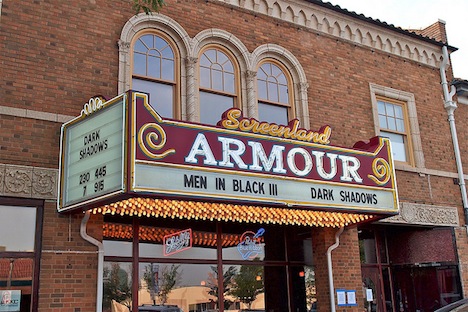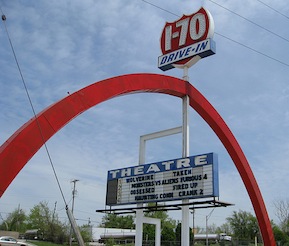 When reporting a business story it’s always a good idea to get a few of the facts straight before you start…
When reporting a business story it’s always a good idea to get a few of the facts straight before you start…
That’s something that was lacking in Wednesday’s Jenee Osterheldt column in the Kansas City Star.
Osterheldt’s story about saving her beloved Screenland Armour, focusing on the theater conversion costs to digital projection, had more holes in it than the Swiss Cheese on my Reuben.
Jenee stated that, “As the movie industry phases out 35mm film and switches entirely to digital production, boutique theaters and indie multiplexes are struggling to make the costly upgrade.”
That’s only partially correct.
It’s not the digital PRODUCTION that’s the problem, it’s digital PROJECTION. Many movies during the past several years have already been shot—or produced—100% digitally.
It’s the digital playback at the theater level – where all new movies (beginning with 2014 releases) will only be PROJECTED digitally – where the conversion expenses come into play. In other words, there will be no more film grinding through projectors.
Jenee goes on to say that, “A lot of big chains have deals with the movie studios that will help cover conversion costs. Not the independents. They’re on their own, and the costs are deep into the thousands.”
 Wrong again.
Wrong again.
A little investigation would have revealed to Osterheldt that so-called “Virtual Print Fees” (VPF’s) are available from the movie studios to ALL theaters. Circuit multiplexes AND independents.
Under the subsidy program any first run theater qualifies for VPF (assistance) fees as long as it opens 80% of new releases on the movie’s national break date.
According to reliable sources VPF’s for each theater can be up to a possible $1,500.- per movie title until the new digital equipment is paid off.
Of course each theaters ownership has to negotiate its own deal and the actual amounts are usually not discussed.
As for independents around the country with fewer screens in their complexes, they may only qualify for half of the VPF subsidy program—or possibly up to $750 per first run booking.
 So whether it’s the mighty Regal, Cinemark or K.C. based AMC and Dickinson – or independent theater operators in Sedalia, Clinton or Nevada, Missouri – the digital conversion costs allegedly follow similar negotiated financial formulas.
So whether it’s the mighty Regal, Cinemark or K.C. based AMC and Dickinson – or independent theater operators in Sedalia, Clinton or Nevada, Missouri – the digital conversion costs allegedly follow similar negotiated financial formulas.
I also found it interesting that the Osterheldt’s story mentioned that locally headquartered Dickinson Theatres had filed for bankruptcy last year.
However what she left out was that it was a Chapter 11 Reorganization filing. And more importantly that Dickinson successfully exited from Chapter 11 several weeks ago.
Very sloppy.
 Finally when reporting on the Boulevard Drive-In‘s conversion to digital projection in 2012, Ms. Osterheldt made no mention of K.C.’s big I-70 four-screen Drive-In or the Twin Drive-In theaters.
Finally when reporting on the Boulevard Drive-In‘s conversion to digital projection in 2012, Ms. Osterheldt made no mention of K.C.’s big I-70 four-screen Drive-In or the Twin Drive-In theaters.
To date neither has converted from 35mm to digital.
I’ll bet a fund raising campaign column by Osterheldt for those two ozoners would be most welcomed as well.










Hmmm…it almost looks like she mis-read something we posted over a year ago.
Nah…couldn’t be.
Regarding the first item, I read “digital production” to mean the physical copies being PRODUCED and distributed were digital, not that she was referring to the “production” that occurs on a movie set. At worst, a failing of the English language and multi-definition industry jargon.
Well, regardless of how you misread it, the issue is all about digital PROJECTION and the cost of having to buy the projectors now that film is on the way out.
In the game of writing, words do matter.
Agreed, admin, you don’t want to leave anybody “hanging from the rafters” or anything like that.
Ask the Five Whys. The change of importance is not projection, that is a manifestation of the change the film industry actually cares about. John Fithian, president of the National Association of Theatre Owners, said: “Digital movies are higher quality than those on film and are cheaper for movie studios to produce and distribute.”
He used the word “produce.” Not “project.”
In the game of writing, being a pedant relegates you to online snark. I shouldn’t have played this game, attacking the Star for any conceivably defensible reason is what this blog is all about.
Nice try, but to borrow on an expression, it’s the projectors, stupid
No lexicon-lingo miscue.
Jenee is an IDIOT!
A few phone calls and some internet research could have provided her the correct info. This ain’t Higgs Boson theory, it’s movies.
Not the first time she’s been off base and uninformed about her subject matter.
She is an embarassment to the Star and all journalists that take time to sufficiently explore their subject matter.
Agree with Smartman. She is often wrong and misinformed and an embarrassment. E-mails to her in the past detailing her mistakes were never answered.
Excellent piece, Jack. It’s the kind of journalism the Star would have done when they were still a meaningful news operation. How she has lasted this long on Grand Avenue boggles the mind. And how all that garbage slipped past her superiors makes you wonder if anyone at the Star still gives a damn. Keep the good columns coming.
Agreed. This kind of sloppiness is just one of the many reasons we don’t subscribe to the KC Star anymore.
This seems rather petty and reeks of sour grapes.
Don’t misunderstand me, nobody actually thinks she is good but the above still stands.
Sour grapes on Jack’s part? No way.
He makes ad buys at the Star and makes money doing so. He’s pals with Bob Butler and Sharon Hoffman. Bad read.